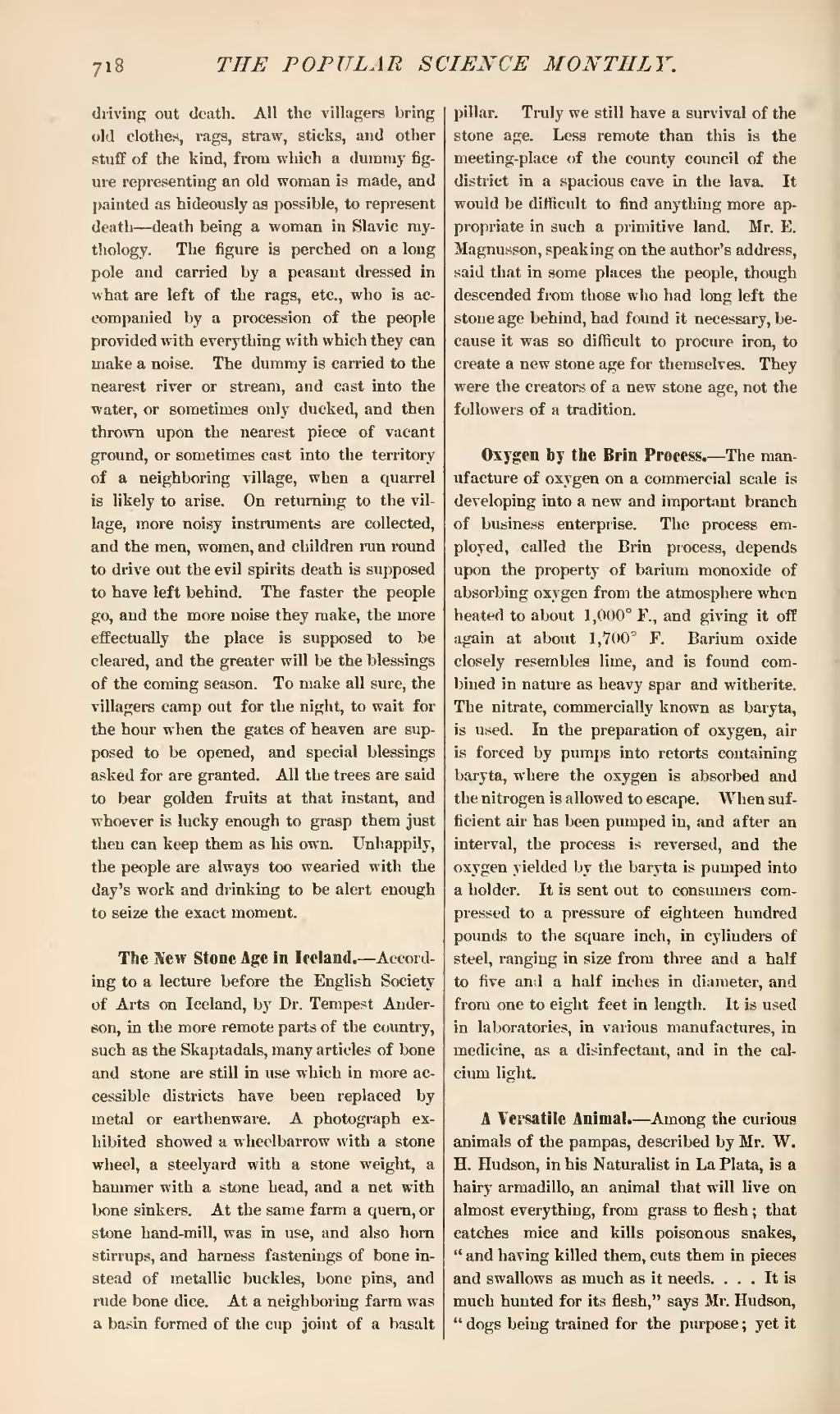driving out death. All the villagers bring old clothes, rags, straw, sticks, and other stuff of the kind, from which a dummy figure representing an old woman is made, and painted as hideously as possible, to represent death—death being a woman in Slavic mythology. The figure is perched on a long pole and carried by a peasant dressed in what are left of the rags, etc., who is accompanied by a procession of the people provided with everything with which they can make a noise. The dummy is carried to the nearest river or stream, and cast into the water, or sometimes only ducked, and then thrown upon the nearest piece of vacant ground, or sometimes cast into the territory of a neighboring village, when a quarrel is likely to arise. On returning to the village, more noisy instruments are collected, and the men, women, and children run round to drive out the evil spirits death is supposed to have left behind. The faster the people go, and the more noise they make, the more effectually the place is supposed to be cleared, and the greater will be the blessings of the coming season. To make all sure, the villagers camp out for the night, to wait for the hour when the gates of heaven are supposed to be opened, and special blessings asked for are granted. All the trees are said to bear golden fruits at that instant, and whoever is lucky enough to grasp them just then can keep them as his own. Unhappily, the people are always too wearied with the day's work and drinking to be alert enough to seize the exact moment.
The New Stone Age in Iceland.—According to a lecture before the English Society of Arts on Iceland, by Dr. Tempest Anderson, in the more remote parts of the country, such as the Skaptadals, many articles of bone and stone are still in use which in more accessible districts have been replaced by metal or earthenware. A photograph exhibited showed a wheelbarrow with a stone wheel, a steelyard with a stone weight, a hammer with a stone head, and a net with bone sinkers. At the same farm a quern, or stone hand-mill, was in use, and also horn stirrups, and harness fastenings of bone instead of metallic buckles, bone pins, and rude bone dice. At a neighboring farm was a basin formed of the cup joint of a basalt pillar. Truly we still have a survival of the stone age. Less remote than this is the meeting-place of the county council of the district in a spacious cave in the lava. It would be difficult to find anything more appropriate in such a primitive land. Mr. E. Magnusson, speaking on the author's address, said that in some places the people, though descended from those who had long left the stone age behind, had found it necessary, because it was so difficult to procure iron, to create a new stone age for themselves. They were the creators of a new stone age, not the followers of a tradition.
Oxygen by the Brin Process.—The manufacture of oxygen on a commercial scale is developing into a new and important branch of business enterprise. The process employed, called the Brin process, depends upon the property of barium monoxide of absorbing oxygen from the atmosphere when heated to about 1,000° F., and giving it off again at about 1,700° F. Barium oxide closely resembles lime, and is found combined in nature as heavy spar and witherite. The nitrate, commercially known as baryta, is used. In the preparation of oxygen, air is forced by pumps into retorts containing baryta, where the oxygen is absorbed and the nitrogen is allowed to escape. When sufficient air has been pumped in, and after an interval, the process is reversed, and the oxygen yielded by the baryta is pumped into a holder. It is sent out to consumers compressed to a pressure of eighteen hundred pounds to the square inch, in cylinders of steel, ranging in size from three and a half to five and a half inches in diameter, and from one to eight feet in length. It is used in laboratories, in various manufactures, in medicine, as a disinfectant, and in the calcium light.
A Versatile Animal.—Among the curious animals of the pampas, described by Mr. W. H. Hudson, in his Naturalist in La Plata, is a hairy armadillo, an animal that will live on almost everything, from grass to flesh; that catches mice and kills poisonous snakes, "and having killed them, cuts them in pieces and swallows as much as it needs. ... It is much hunted for its flesh," says Mr. Hudson, "dogs being trained for the purpose; yet it
